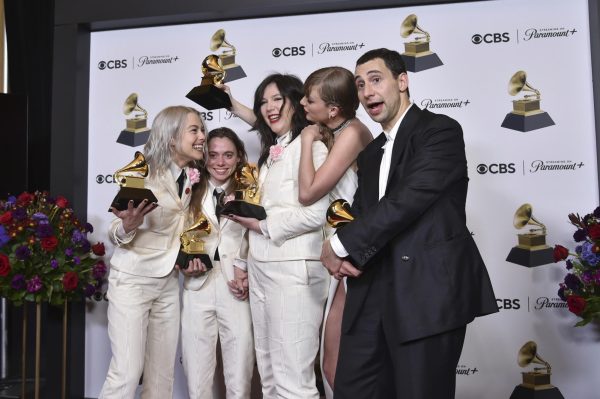Album Review: Gracie Abrams’ “Good Riddance”
“Good Riddance” is the debut album of American singer-songwriter Gracie Abrams. It was released on Feb. 24 of this year by Interscope Records. Abrams is relatively new to the scene, having started her career with the release of her debut single and EP in 2019 and 2020, respectively. Still, she has managed to make a name for herself in the short period of time that she has been active. Abrams will be one of the openers, along with Phoebe Bridgers and HAIM, for Taylor Swift on the musical icon’s upcoming Eras Tour. Despite her short career, Abrams is becoming a favored artist for some listeners.
“I’ve been listening to Gracie for over a year now, and I can easily say she is one of my favorite artists. […] She’s been getting tons of recognition lately, much more than when I started listening to her. It makes me happy to know more people are listening to her than ever before,” said junior Sara Howe.
Abrams worked with Grammy-winning producer and songwriter Aaron Dessner on “Good Riddance.” Dessner was very involved in this project, holding producing and writing credits on every track of the album. As for the sound, Abrams’ particular brand of vocal styling allows for the songwriting and producing to shine through on this record. The singer has a slightly raspy, spoken singing voice that doesn’t lean towards the high notes or belts that many other singers have been known to showcase on their own pop records. Instead, the singer creates a close environment between herself and the listener for this pop album.
“I have absolutely enjoyed her debut album. I love how honest it is,” Howe said.
The themes of the songs are largely confessional and melancholy. Many of them center around relationships that are not going smoothly for a variety of reasons. The first track “Best” is about the insecurity one feels in a relationship — specifically not being the “best” for another person. In “I know it won’t work” Abrams wishes for a relationship to be repaired but understands those hopes will not come to fruition. As the title suggests, “Where do we go now?” is about uncertainty regarding where a relationship is headed. The lyricism shows an introspectiveness from Abrams that is undoubtedly impressive from a 23 year-old. Often in her songs, the singer is sharing some of the blame and most of the uncertainty for the failed or suffering relationships. The intimacy that Abrams has created with her speaking-like vocal stylings and lyrics is part of why some fans enjoy her music, which Howe points out:
“I love how real her music is; it really feels like she is talking directly to you. The way she sings with so much vulnerability feels raw and authentic. Some people have been critical of her having soft, ‘breathy’ vocals but I think it adds to the realness of her music.”
While there may be high expectations for “Good Riddance,” it will serve the audience to keep in mind that Abrams is still shaping herself as an artist, and this album is probably just the first of many planned projects. That might serve as an explanation as to why, despite impressive credentials and mature songwriting, there is still room for the artist to take bigger risks in her music. While the songwriting and production on this album are not lazy, the choices made by the record’s collaborators were obviously safe ones that sometimes leave the impression that the project is monotonous. As Pitchfork wrote, “[…] with melodic repetition and unadventurous production, the record is often stagnant, leaving you wishing for a more sophisticated, compelling take on whisperpop.” For a producer as talented as Dessner, “Good Riddance” could have served as a new take on indie-pop. Instead, many of the songs get lost in the same dreamy sound with softly-delivered lyrics.
That said, “Good Riddance” shows us that Abrams can take her craft one step further. The tracks “This is what the drugs are for” and “Difficult” are more fast-paced and prove that the singer’s whisper-like voice can keep up with a quicker tempo and production. On “Difficult,” the listener can clearly hear drums, which steers away from the largely bedroom-pop sound of the record. “Amelie,” which Abrams noted as a favorite of hers and Dessner’s, is unique in its lyricism as it places a name on the person Abrams is singing about – an aspect that is not present in the other songs. The vocals of “Amelie” are accompanied by an acoustic guitar, which creates a more stripped down sound that again stands out among the majority of the album’s production.
Despite Abrams choosing a more predictable route for her art this time around, she is an artist who has only released a debut album and could explore her creativity as her career progresses. In the meantime, the young singer has still produced a mature, thoughtful record that has given us a glimpse into her burgeoning talent. As Howe said, “…I think some of the songs are a bit similar to each other, so maybe it’s just a bit lacking in variety. Overall, [“Good Riddance”] feels more adult than her older works, and as a listener, it’s so nice to feel that I am growing up with her and her music.”

Maya Karkhanis is a senior from Hillsborough, NJ concentrating in international relations, religion, and Asian studies. She has previously served as an...









